Detection of Fire Smoke Plumes Based on Aerosol Scattering Using VIIRS Data over Global Fire-Prone Regions
Abstract
1. Introduction
2. Data
2.1. Study Area
2.2. VIIRS Sensor Data Record
2.3. VIIRS True-Color Imagery
2.4. VIIRS Active Fire
2.5. VIIRS Enterprise Cloud Mask
2.6. Datasets for Evaluating Smoke Detection
2.6.1. VIIRS Aerosol Products
2.6.2. TROPOMI Smoke
2.6.3. Manually-Delineated Smoke Plumes
3. Methodology
3.1. Design of Detection Criteria
3.2. Smoke Detection Procedure
3.3. Accuracy Assessment
4. Results
4.1. Qualitative Evaluation of the SSDA Smoke Detections
4.1.1. Qualitative Evaluation Using True-Color Images
4.1.2. Qualitative Evaluation Using VIIRS ADP and TROPOMI Smoke
4.1.3. Qualitative Evaluation Using Published Results
4.2. Quantitative Evaluation of the SSDA Smoke Detections
4.2.1. Comparison of AOD Values between Smoke and Non-smoke Pixels
4.2.2. Validation of SSDA Smoke Detections Using Manually-Delineated Smoke Reference Data
4.3. Global Smoke Map
5. Discussion
- The theoretical basis is the strong Mie scattering at blue and green bands caused by smoke aerosols. These two bands are more commonly available on satellite sensors than ultraviolet bands.
- The corrected reflectance, instead of TOA reflectance, of the blue band is used, which enhances potential contrast between smoke and non-smoke areas because it reduces considerable impacts from Rayleigh scattering but keeps important information from aerosol scattering for the wavelength spectrum corresponding to smoke aerosol particulate sizes.
- Using multiple criteria (spectral and spatial) in a stepwise way (4 steps) in the SSDA reduces potential commission errors and large uncertainties (see following paragraphs) as much as possible, since no unique features allow separation of smoke from other surface types.
- The detection of thin smoke released from small fires is greatly improved, which could help people monitor fire development at early stages, and then take relevant actions to prevent major fire events from developing.
- Detection of dense smoke emitted from large fires is also greatly enhanced with lower commission and omission errors in North America and Siberia, which could improve the accuracy of biomass burning emissions estimates by combining it with AOD or carbon monoxide observations using chemistry-transport models.
- The method of smoke detection can be applied efficiently at a global scale.
6. Conclusions
Author Contributions
Funding
Institutional Review Board Statement
Informed Consent Statement
Data Availability Statement
Acknowledgments
Conflicts of Interest
References
- Price, O.F.; Purdam, P.J.; Williamson, G.J.; Bowman, D.M. Comparing the height and area of wild and prescribed fire particle plumes in south-east Australia using weather radar. Int. J. Wildland Fire 2018, 27, 525–537. [Google Scholar] [CrossRef]
- Marlier, M.E.; DeFries, R.S.; Kim, P.S.; Koplitz, S.N.; Jacob, D.J.; Mickley, L.J.; Myers, S.S. Fire emissions and regional air quality impacts from fires in oil palm, timber, and logging concessions in Indonesia. Environ. Res. Lett. 2015, 10, 085005. [Google Scholar] [CrossRef]
- Bond, T.C.; Doherty, S.J.; Fahey, D.W.; Forster, P.M.; Berntsen, T.; DeAngelo, B.J.; Flanner, M.G.; Ghan, S.; Kärcher, B.; Koch, D. Bounding the role of black carbon in the climate system: A scientific assessment. J. Geophys. Res. Atmos. 2013, 118, 5380–5552. [Google Scholar] [CrossRef]
- Stohl, A.; Klimont, Z.; Eckhardt, S.; Kupiainen, K.; Shevchenko, V.P.; Kopeikin, V.; Novigatsky, A. Black carbon in the Arctic: The underestimated role of gas flaring and residential combustion emissions. Atmos. Chem. Phys. 2013, 13, 8833–8855. [Google Scholar] [CrossRef]
- Koren, I.; Kaufman, Y.J.; Remer, L.A.; Martins, J.V. Measurement of the effect of Amazon smoke on inhibition of cloud formation. Science 2004, 303, 1342–1345. [Google Scholar] [CrossRef]
- Spracklen, D.V.; Carslaw, K.S.; Kulmala, M.; Kerminen, V.M.; Sihto, S.L.; Riipinen, I.; Merikanto, J.; Mann, G.W.; Chipperfield, M.P.; Wiedensohler, A. Contribution of particle formation to global cloud condensation nuclei concentrations. Geophys. Res. Lett. 2008, 35. [Google Scholar] [CrossRef]
- Brook, R.D.; Rajagopalan, S.; Pope, C.A., III; Brook, J.R.; Bhatnagar, A.; Diez-Roux, A.V.; Holguin, F.; Hong, Y.; Luepker, R.V.; Mittleman, M.A. Particulate matter air pollution and cardiovascular disease: An update to the scientific statement from the American Heart Association. Circulation 2010, 121, 2331–2378. [Google Scholar] [CrossRef]
- Ismanto, H.; Hartono, H.; Marfai, M.A. Smoke detections and visibility estimation using Himawari_8 satellite data over Sumatera and Borneo Island Indonesia. Spat. Inf. Res. 2019, 27, 205–216. [Google Scholar] [CrossRef]
- Ghirardelli, J.E.; Glahn, B. The Meteorological Development Laboratory’s aviation weather prediction system. Weather Forecast. 2010, 25, 1027–1051. [Google Scholar] [CrossRef]
- Brey, S.J.; Ruminski, M.; Atwood, S.A.; Fischer, E.V. Connecting smoke plumes to sources using Hazard Mapping System (HMS) smoke and fire location data over North America. Atmos. Chem. Phys. 2018, 18, 1745–1761. [Google Scholar] [CrossRef]
- Hsu, N.; Herman, J.; Bhartia, P.; Seftor, C.; Torres, O.; Thompson, A.; Gleason, J.; Eck, T.; Holben, B. Detection of biomass burning smoke from TOMS measurements. Geophys. Res. Lett. 1996, 23, 745–748. [Google Scholar] [CrossRef]
- Leroy-Cancellieri, V.; Augustin, P.; Filippi, J.-B.; Mari, C.; Fourmentin, M.; Bosseur, F.; Morandini, F.; Delbarre, H. Evaluation of wildland fire smoke plume dynamics and aerosol load using UV scanning lidar and fire-atmosphere modelling during the Mediterranean Letia 2010 experiment. Nat. Hazards Earth Syst. Sci. 2014, 14, 509–523. [Google Scholar] [CrossRef]
- Akimoto, H. Global air quality and pollution. Science 2003, 302, 1716–1719. [Google Scholar] [CrossRef] [PubMed]
- Tosca, M.G.; Randerson, J.T.; Zender, C.S.; Nelson, D.L.; Diner, D.J.; Logan, J.A. Dynamics of fire plumes and smoke clouds associated with peat and deforestation fires in Indonesia. J. Geophys. Res. 2011, 116, 1–14. [Google Scholar] [CrossRef]
- Wang, W.; Qu, J.J.; Hao, X.; Liu, Y.; Sommers, W.T. An improved algorithm for small and cool fire detection using MODIS data: A preliminary study in the southeastern United States. Remote Sens. Environ. 2007, 108, 163–170. [Google Scholar] [CrossRef]
- Li, Z.; Khananian, A.; Fraser, R.H.; Cihlar, J. Automatic detection of fire smoke using artificial neural networks and threshold approaches applied to AVHRR imagery. Ieee Trans. Geosci. Remote Sens. 2001, 39, 1859–1870. [Google Scholar]
- Nelson, D.L.; Garay, M.J.; Kahn, R.A.; Dunst, B.A. Stereoscopic height and wind retrievals for aerosol plumes with the MISR INteractive eXplorer (MINX). Remote Sens. 2013, 5, 4593–4628. [Google Scholar] [CrossRef]
- Williamson, G.J.; Price, O.F.; Henderson, S.B.; Bowman, D.M. Satellite-based comparison of fire intensity and smoke plumes from prescribed fires and wildfires in south-eastern Australia. Int. J. Wildland Fire 2013, 22, 121–129. [Google Scholar] [CrossRef]
- Lu, X.; Zhang, X.; Li, F.; Cochrane, M.A. Investigating Smoke Aerosol Emission Coefficients using MODIS Active Fire and Aerosol Products—A Case Study in the CONUS and Indonesia. J. Geophys. Res. Biogeosciences 2019, 124, 1413–1429. [Google Scholar] [CrossRef]
- Mota, B.; Wooster, M.J. A new top-down approach for directly estimating biomass burning emissions and fuel consumption rates and totals from geostationary satellite fire radiative power (FRP). Remote Sens. Environ. 2018, 206, 45–62. [Google Scholar] [CrossRef]
- Schroeder, W.; Ruminski, M.; Csiszar, I.; Giglio, L.; Prins, E.; Schmidt, C.; Morisette, J. Validation analyses of an operational fire monitoring product: The Hazard Mapping System. Int. J. Remote Sens. 2008, 29, 6059–6066. [Google Scholar] [CrossRef]
- Li, X.; Song, W.; Lian, L.; Wei, X. Forest fire smoke detection using back-propagation neural network based on MODIS data. Remote Sens. 2015, 7, 4473–4498. [Google Scholar] [CrossRef]
- Ba, R.; Chen, C.; Yuan, J.; Song, W.; Lo, S. SmokeNet: Satellite smoke scene detection using convolutional neural network with spatial and channel-wise attention. Remote Sens. 2019, 11, 1702. [Google Scholar] [CrossRef]
- Herman, J.; Bhartia, P.; Torres, O.; Hsu, C.; Seftor, C.; Celarier, E. Global distribution of UV-absorbing aerosols from Nimbus 7/TOMS data. J. Geophys. Res. Atmos. 1997, 102, 16911–16922. [Google Scholar] [CrossRef]
- Buchard, V.; Da Silva, A.; Colarco, P.; Darmenov, A.; Randles, C.; Govindaraju, R.; Torres, O.; Campbell, J.; Spurr, R. Using the OMI aerosol index and absorption aerosol optical depth to evaluate the NASA MERRA Aerosol Reanalysis. Atmos. Chem. Phys. 2015, 15, 5743. [Google Scholar] [CrossRef]
- Li, F.; Zhang, X.; Kondragunta, S.; Lu, X. An evaluation of Advanced Baseline Imager fire radiative power based wildfire emissions using carbon monoxide observed by the Tropospheric Monitoring Instrument across the Conterminous United States. Environ. Res. Lett. 2020, 15, 094049. [Google Scholar] [CrossRef]
- Kaufman, Y.J.; Tanré, D.; Boucher, O. A satellite view of aerosols in the climate system. Nature 2002, 419, 215. [Google Scholar] [CrossRef]
- NOAA/NESDIS/STAR. JPSS Aerosol Detection (Suspended Matter) Product Algorithm Theoretical Basis Document. Noaa Nesdis Cent. Satell. Appl. Res. 2016. Available online: https://www.ospo.noaa.gov/Products/Suites/files/atbd/JPSS_RR_ADP_ATBD_version1_updated.pdf (accessed on 7 January 2021).
- De Graaf, M.; Stammes, P.; Torres, O.; Koelemeijer, R. Absorbing Aerosol Index: Sensitivity analysis, application to GOME and comparison with TOMS. J. Geophys. Res. Atmos. 2005, 110, D01201. [Google Scholar] [CrossRef]
- De Vries, M.; Beirle, S.; Wagner, T. UV Aerosol Indices from SCIAMACHY: Introducing the SCattering Index (SCI). Atmos. Chem. Phys. 2009, 9, 9555–9567. [Google Scholar] [CrossRef]
- Giglio, L.; Van der Werf, G.; Randerson, J.; Collatz, G.; Kasibhatla, P. Global estimation of burned area using MODIS active fire observations. Atmos. Chem. Phys. 2006, 6, 957–974. [Google Scholar] [CrossRef]
- Van Der Werf, G.R.; Randerson, J.T.; Giglio, L.; Collatz, G.J.; Kasibhatla, P.S.; Arellano Jr, A.F. Interannual variability in global biomass burning emissions from 1997 to 2004. Atmos. Chem. Phys. 2006, 6, 3423–3441. [Google Scholar] [CrossRef]
- Reid, J.; Koppmann, R.; Eck, T.; Eleuterio, D. A review of biomass burning emissions part II: Intensive physical properties of biomass burning particles. Atmos. Chem. Phys. 2005, 5, 799–825. [Google Scholar] [CrossRef]
- Reid, J.S.; Eck, T.F.; Christopher, S.A.; Koppmann, R.; Dubovik, O.; Eleuterio, D.; Holben, B.N.; Reid, E.A.; Zhang, J. A review of biomass burning emissions part III: Intensive optical properties of biomass burning particles. Atmos. Chem. Phys. 2005, 5, 827–849. [Google Scholar] [CrossRef]
- Archibald, S.; Lehmann, C.E.; Gómez-Dans, J.L.; Bradstock, R.A. Defining pyromes and global syndromes of fire regimes. Proc. Natl. Acad. Sci. USA 2013, 110, 6442–6447. [Google Scholar] [CrossRef] [PubMed]
- Liu, T.; Mickley, L.J.; Marlier, M.E.; DeFries, R.S.; Khan, M.F.; Latif, M.T.; Karambelas, A. Diagnosing spatial biases and uncertainties in global fire emissions inventories: Indonesia as regional case study. Remote Sens. Environ. 2020, 237, 111557. [Google Scholar] [CrossRef]
- Heil, A.; Goldammer, J. Smoke-haze pollution: A review of the 1997 episode in Southeast Asia. Reg. Environ. Chang. 2001, 2, 24–37. [Google Scholar] [CrossRef]
- Rayleigh, L. On the transmission of light through an atmosphere containing small particles in suspension, and on the origin of the blue of the sky. Lond. Edinb. Dublin Philos. Mag. J. Sci. 1899, 47, 375–384. [Google Scholar] [CrossRef]
- Laboratory, D.R. Creating Reprojected True Color VIIRS Images: A Tutorial. 2016. Available online: https://directreadout.sci.gsfc.nasa.gov/links/rsd_eosdb/PDF/VIIRS_True_Color_Tutorial_v1.0.pdf (accessed on 7 January 2021).
- Schroeder, W.; Giglio, L. Visible Infrared Imaging Radiometer Suite (VIIRS) 750 m Active Fire Detection and Characterization Algorithm Theoretical Basis Document 1.0. 2017. Available online: https://lpdaac.usgs.gov/documents/133/VNP14_ATBD.pdf (accessed on 7 January 2021).
- Giglio, L.; Schroeder, W.; Csiszar, I.; Tsidulko, M. Algorithm Theoretical Basis Document for NOAA NDE VIIRS Active Fire. 2016. Available online: https://www.star.nesdis.noaa.gov/jpss/documents/ATBD/ATBD_NDE_AF_v2.6.pdf (accessed on 6 January 2021).
- Li, F.; Zhang, X.; Kondragunta, S.; Csiszar, I. Comparison of fire radiative power estimates from VIIRS and MODIS observations. J. Geophys. Res. Atmos. 2018, 123, 4545–4563. [Google Scholar] [CrossRef]
- Heidinger, A.; Botambekov, D.; Walther, A. A Naïve Bayesian Cloud Mask Delivered to NOAA Enterprise. Version 1.2; 2016. Available online: https://www.star.nesdis.noaa.gov/goesr/documents/ATBDs/Enterprise/ATBD_Enterprise_Cloud_Mask_v1.2_Oct2016.pdf (accessed on 7 January 2021).
- White, C.H.; Heidinger, A.K.; Ackerman, S.A. Evaluation of VIIRS Neural Network Cloud Detection against Current Operational Cloud Masks. Atmos. Meas. Tech. Discuss. 2020, 1–34. [Google Scholar] [CrossRef]
- Laszlo, I.; Liu, H. EPS Aerosol Optical Depth (AOD) Algorithm Theoretical Basis Document. Noaa Nesdis Cent. Satell. Appl. Res. 2016. Available online: https://www.star.nesdis.noaa.gov/jpss/documents/ATBD/ATBD_EPS_Aerosol_AOD_v3.0.1.pdf (accessed on 7 January 2021).
- Zweers, S.D. TROPOMI ATBD of the UV Aerosol Index. 2018. Available online: http://www.tropomi.eu/sites/default/files/files/S5P-KNMI-L2-0008-RP-TROPOMI_ATBD_UVAI-1.1.0-20180615_signed.pdf (accessed on 7 January 2021).
- Giglio, L.; Randerson, J.T.; Werf, G.R. Analysis of daily, monthly, and annual burned area using the fourth-generation global fire emissions database (GFED4). J. Geophys. Res. Biogeosciences 2013, 118, 317–328. [Google Scholar] [CrossRef]
- Zhang, X.; Kondragunta, S.; Ram, J.; Schmidt, C.; Huang, H.-C. Near-real-time global biomass burning emissions product from geostationary satellite constellation. J. Geophys. Res. Atmos. 2012, 117, D14201. [Google Scholar] [CrossRef]
- Shi, Z.; Wang, Q.; Peng, J.; Ji, W.; Liu, H.; Li, X.; Rossel, R.A.V. Development of a national VNIR soil-spectral library for soil classification and prediction of organic matter concentrations. Sci. China Earth Sci. 2014, 57, 1671–1680. [Google Scholar] [CrossRef]
- Hinds, W.C. Aerosol Technology Properties, Behavior, and Measurement of Airborne Particles; Wiley lnterscience: New York, NY, USA, 1982. [Google Scholar] [CrossRef]
- Chrysoulakis, N.; Cartalis, C. A new algorithm for the detection of plumes caused by industrial accidents, based on NOAA/AVHRR imagery. Int. J. Remote Sens. 2003, 24, 3353–3368. [Google Scholar] [CrossRef]
- Chrysoulakis, N.; Herlin, I.; Prastacos, P.; Yahia, H.; Grazzini, J.; Cartalis, C. An improved algorithm for the detection of plumes caused by natural or technological hazards using AVHRR imagery. Remote Sens. Environ. 2007, 108, 393–406. [Google Scholar] [CrossRef]
- Zhao, T.X.-P.; Ackerman, S.; Guo, W. Dust and smoke detection for multi-channel imagers. Remote Sens. 2010, 2, 2347–2368. [Google Scholar] [CrossRef]
- Stroppiana, D.; Pinnock, S.; Gregoire, J.-M. The global fire product: Daily fire occurrence from April 1992 to December 1993 derived from NOAA AVHRR data. Int. J. Remote Sens. 2000, 21, 1279–1288. [Google Scholar] [CrossRef]
- Giglio, L.; Descloitres, J.; Justice, C.O.; Kaufman, Y.J. An enhanced contextual fire detection algorithm for MODIS. Remote Sens. Environ. 2003, 87, 273–282. [Google Scholar] [CrossRef]
- Buiteveld, H.; Hakvoort, J.; Donze, M. Optical properties of pure water. Ocean Optics XII. 1994, 2258, 174–183. [Google Scholar] [CrossRef]
- News, S. The numbers behind Australia’s catastropic bushfire season. Sbs News 2020. Available online: https://www.sbs.com.au/news/the-numbers-behind-australia-s-catastrophic-bushfire-season (accessed on 7 January 2021).
- Xie, Y.; Qu, J.; Xiong, X.; Hao, X.; Che, N.; Sommers, W. Smoke plume detection in the eastern United States using MODIS. Int. J. Remote Sens. 2007, 28, 2367–2374. [Google Scholar] [CrossRef]
- Schueler, C.F. Dual Use Sensor Design for Enhanced Spatioradiometric Performance. U.S. Patent No. 5,682,034., 28 October 1997. [Google Scholar]
- Hsu, N.C.; Herman, J.; Torres, O.; Holben, B.; Tanre, D.; Eck, T.; Smirnov, A.; Chatenet, B.; Lavenu, F. Comparisons of the TOMS aerosol index with Sun-photometer aerosol optical thickness: Results and applications. J. Geophys. Res. Atmos. 1999, 104, 6269–6279. [Google Scholar] [CrossRef]
- Shyamsundar, P.; Springer, N.; Tallis, H.; Polasky, S.; Jat, M.; Sidhu, H.; Krishnapriya, P.; Skiba, N.; Ginn, W.; Ahuja, V. Fields on fire: Alternatives to crop residue burning in India. Science 2019, 365, 536–538. [Google Scholar] [CrossRef] [PubMed]
- Landrigan, P.J.; Fuller, R.; Acosta, N.J.; Adeyi, O.; Arnold, R.; Baldé, A.B.; Bertollini, R.; Bose-O’Reilly, S.; Boufford, J.I.; Breysse, P.N. The Lancet Commission on pollution and health. Lancet 2018, 391, 462–512. [Google Scholar] [CrossRef]
- Wooster, M.; Zhukov, B.; Oertel, D. Fire radiative energy for quantitative study of biomass burning: Derivation from the BIRD experimental satellite and comparison to MODIS fire products. Remote Sens. Environ. 2003, 86, 83–107. [Google Scholar] [CrossRef]
- Giglio, L.; Boschetti, L.; Roy, D.P.; Humber, M.L.; Justice, C.O. The Collection 6 MODIS burned area mapping algorithm and product. Remote Sens. Environ. 2018, 217, 72–85. [Google Scholar] [CrossRef] [PubMed]
- Chuvieco, E.; Mouillot, F.; van der Werf, G.R.; San Miguel, J.; Tanasse, M.; Koutsias, N.; García, M.; Yebra, M.; Padilla, M.; Gitas, I. Historical background and current developments for mapping burned area from satellite Earth observation. Remote Sens. Environ. 2019, 225, 45–64. [Google Scholar] [CrossRef]
- Van Der Werf, G.R.; Randerson, J.T.; Giglio, L.; Van Leeuwen, T.T.; Chen, Y.; Rogers, B.M.; Mu, M.; Van Marle, M.J.; Morton, D.C.; Collatz, G.J. Global fire emissions estimates during 1997–2016. Earth Syst. Sci. Data 2017, 9, 697–720. [Google Scholar] [CrossRef]
- Jackson, J.M.; Liu, H.; Laszlo, I.; Kondragunta, S.; Remer, L.A.; Huang, J.; Huang, H.-C. Suomi-NPP VIIRS aerosol algorithms and data products. J. Geophys. Res. Atmos. 2013, 118, 12673–12689. [Google Scholar] [CrossRef]
- De Graaf, M.; Stammes, P. SCIAMACHY Absorbing Aerosol Index—Calibration issues and global results from 2002–2004. Atmos. Chem. Phys. 2005, 5, 2385–2394. [Google Scholar] [CrossRef]
- Vermote, E.; Tanré, D.; Deuzé, J.; Herman, M.; Morcrette, J.; Kotchenova, S. Second Simulation of a Satellite Signal in the Solar Spectrum—Vector (6SV); 6S User Guide Version 3. Nasa Goddard Space Flight Cent. Greenbeltmdusa 2006. Available online: https://www.researchgate.net/publication/247461276_Second_simulation_of_a_satellite_signal_in_the_solar_spectrum-vector_6SV (accessed on 7 January 2021).
- Kondragunta, S.; Laszlo, I.; Ma, L.; Office, J.P. NOAA JPSS Visible Infrared Imaging Radiometer Suite (VIIRS) Aerosol Optical Depth and Aerosol Particle Size Distribution Environmental Data Record (EDR) from NDE. Noaa Natl. Cent. Environ. Inf. 2017. [Google Scholar] [CrossRef]
- Zhang, X.; Kondragunta, S.; Roy, D.P. Interannual variation in biomass burning and fire seasonality derived from Geostationary satellite data across the contiguous United States from 1995 to 2011. J. Geophys. Res. Biogeosciences 2014, 119, 1147–1162. [Google Scholar] [CrossRef]
- Kaiser, J.; Heil, A.; Andreae, M.; Benedetti, A.; Chubarova, N.; Jones, L.; Morcrette, J.-J.; Razinger, M.; Schultz, M.; Suttie, M. Biomass burning emissions estimated with a global fire assimilation system based on observed fire radiative power. Biogeosciences 2012, 9, 527–554. [Google Scholar] [CrossRef]
- Darmenov, A.; da Silva, A. The quick fire emissions dataset (QFED)–documentation of versions 2.1, 2.2 and 2.4. Nasa Tech. Rep. Ser. Glob. Modeling Data Assim. 2015, 38. Available online: https://ntrs.nasa.gov/api/citations/20180005253/downloads/20180005253.pdf (accessed on 6 January 2021).
- McMahon, C.K. Characteristics of forest fuels, fire and emissions. In Proceedings of the 76th Annual Meeting of Air Pollution Control Association, Atlanta, GA, USA, 19–24 June 1983; 24p. [Google Scholar]
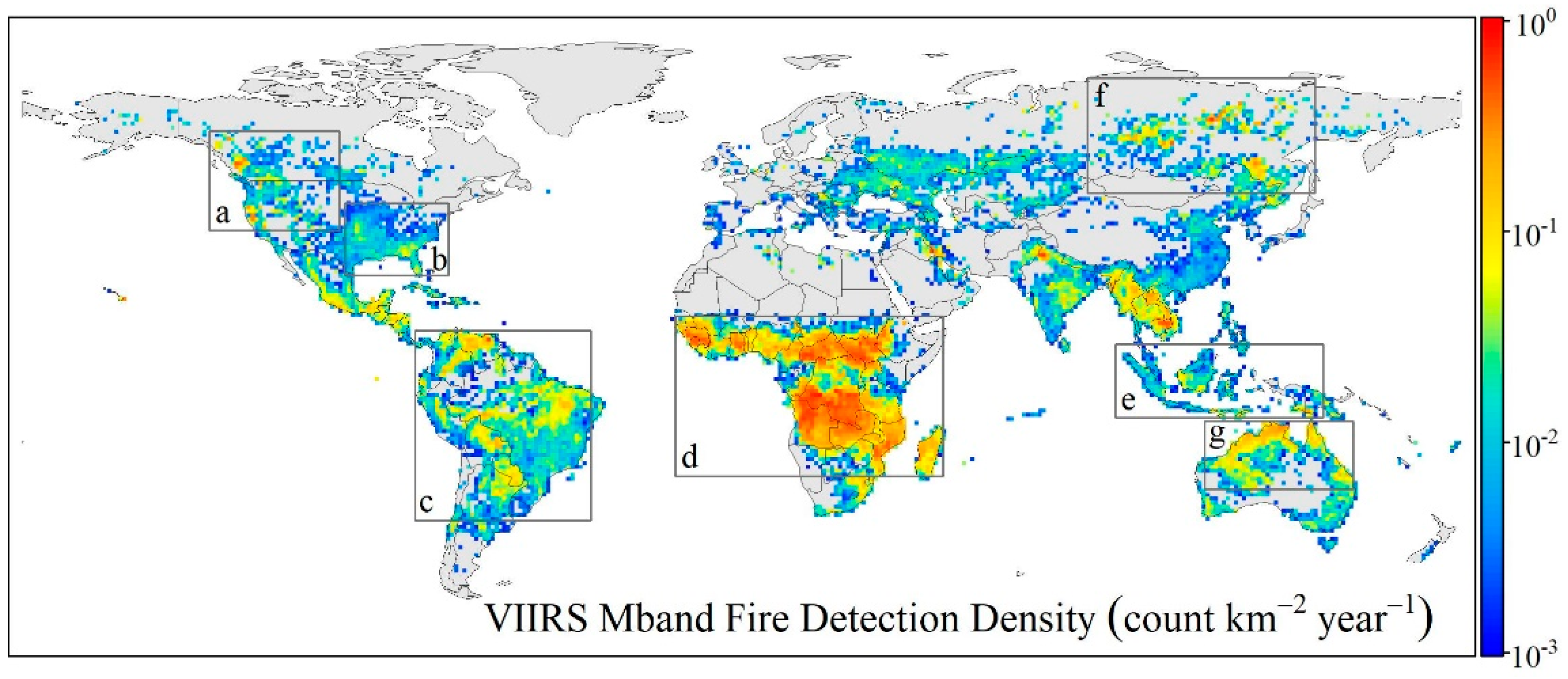
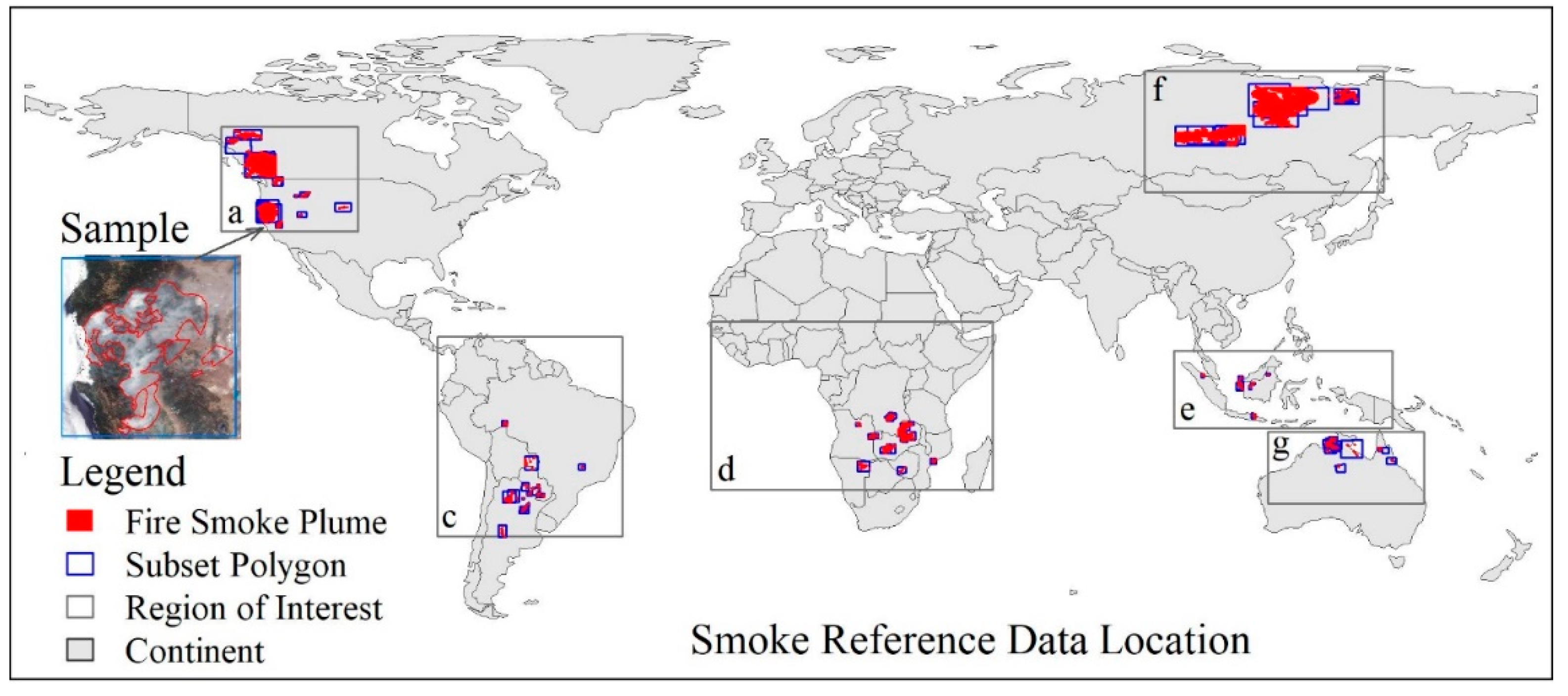

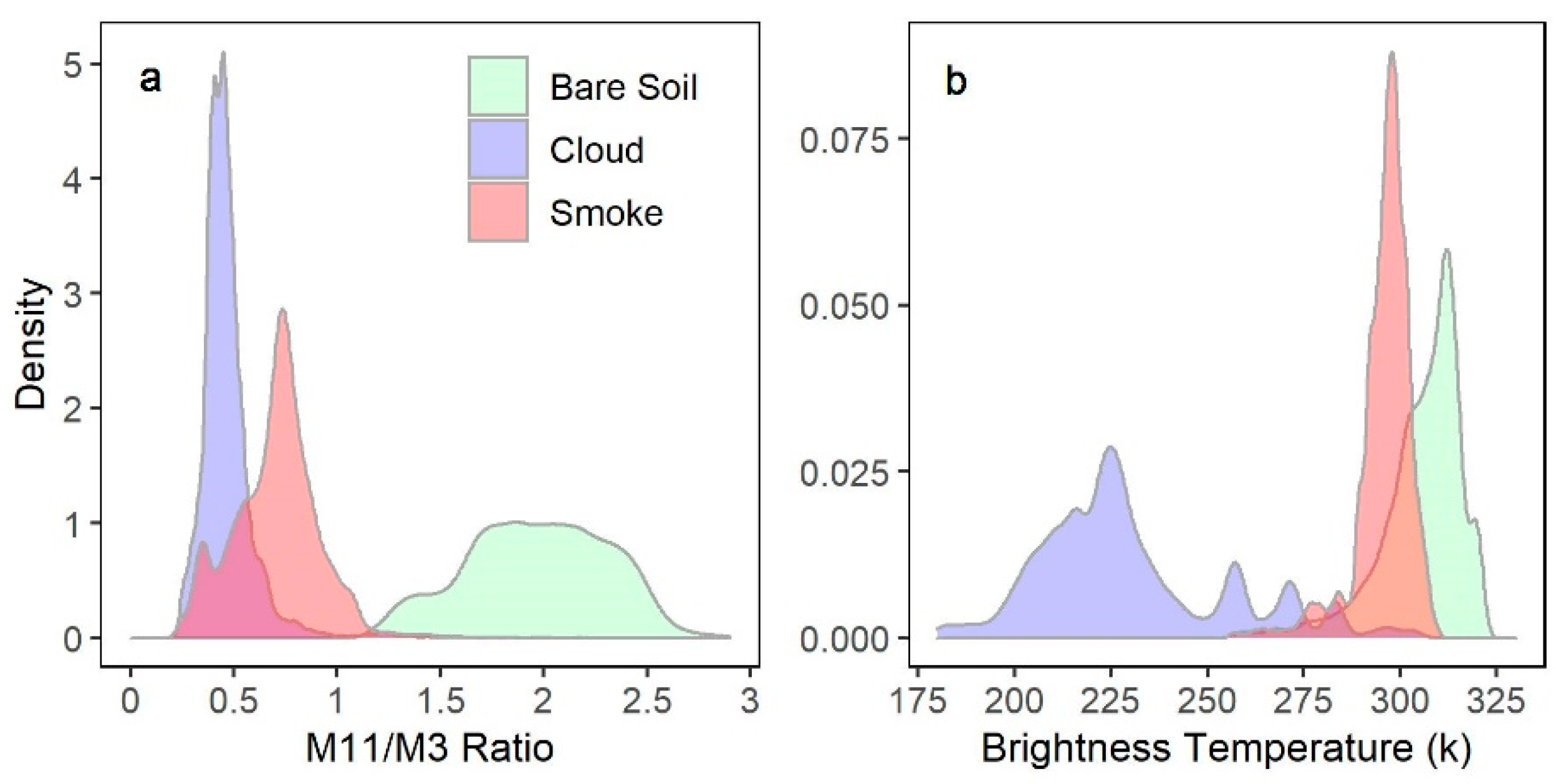
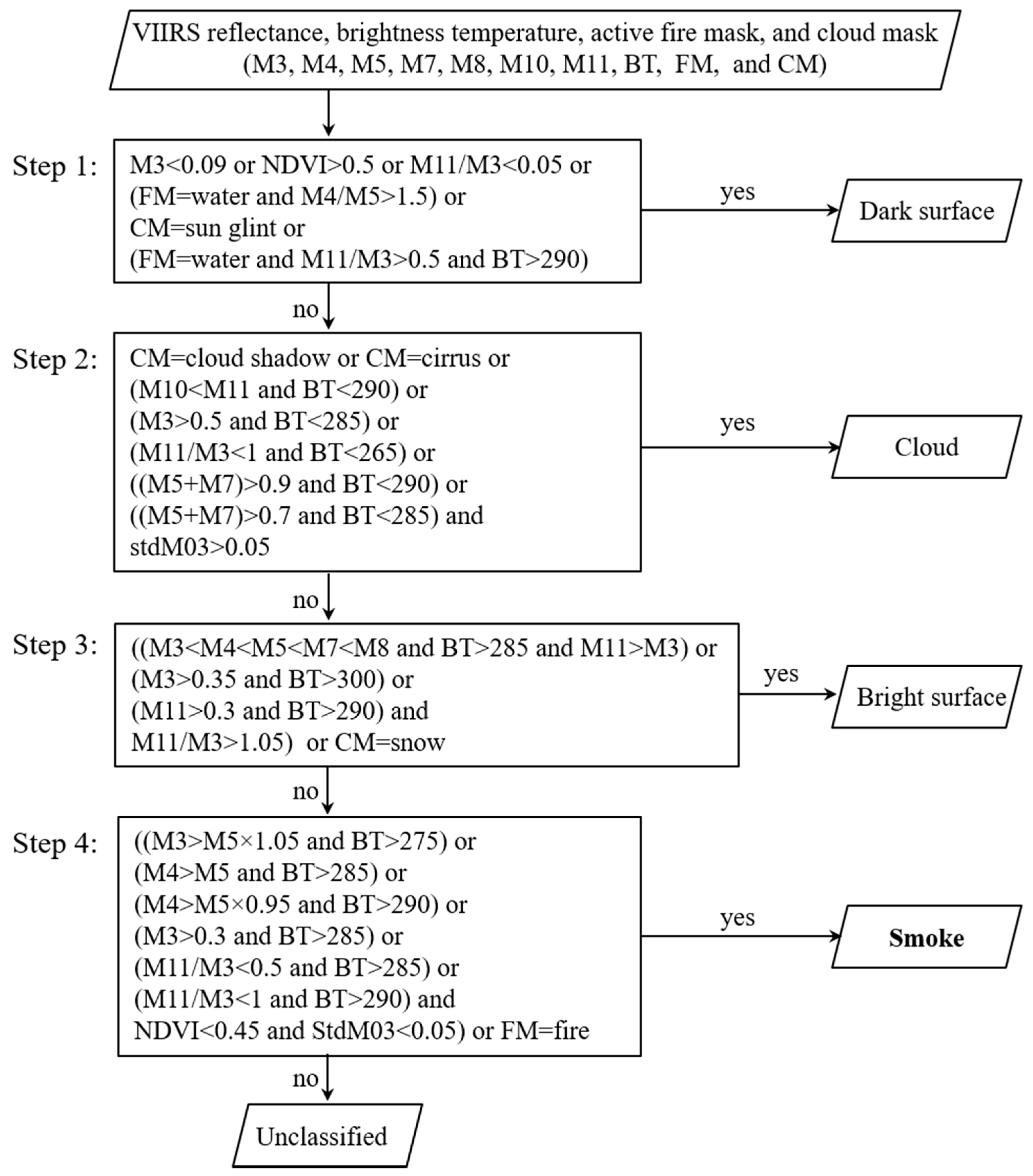
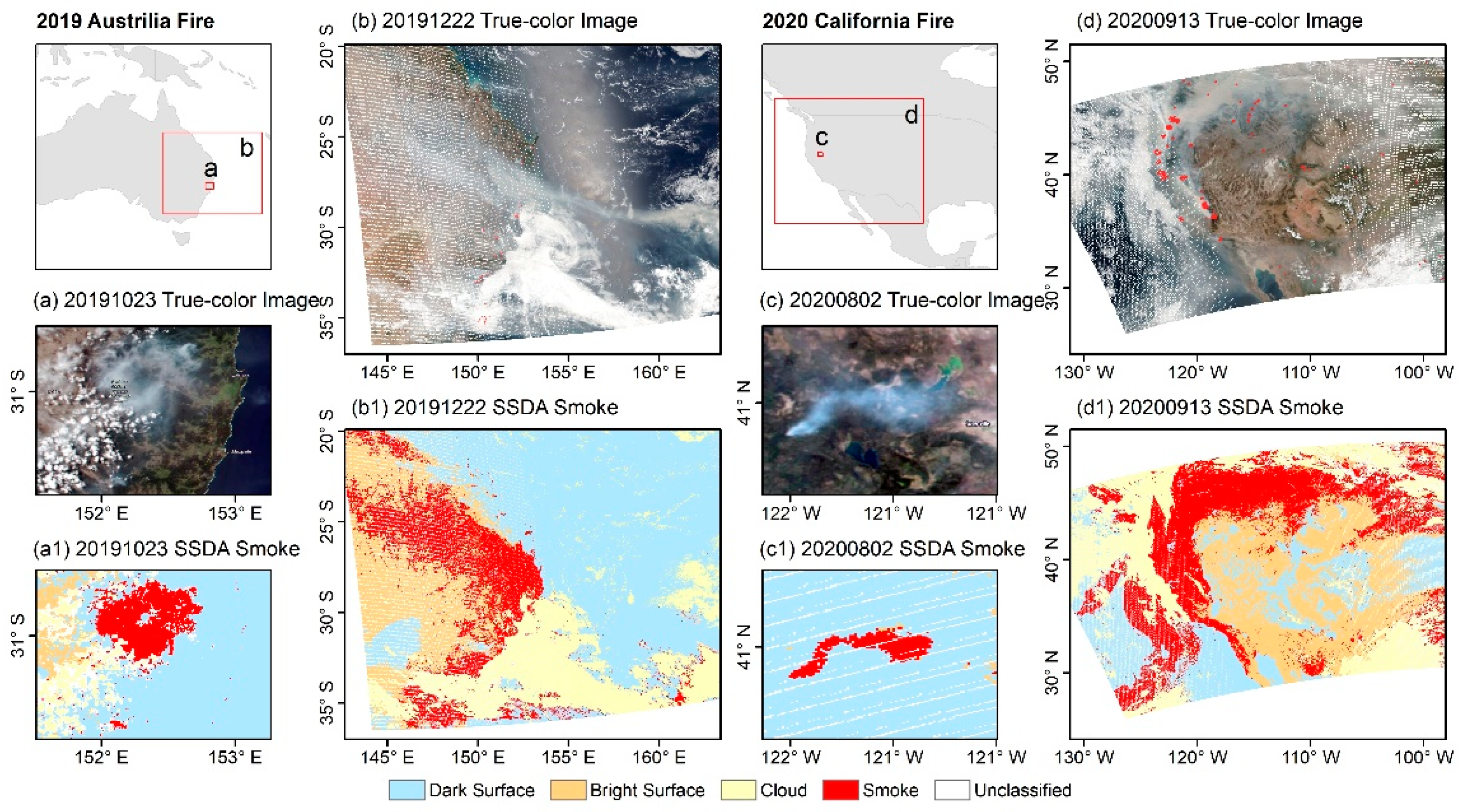
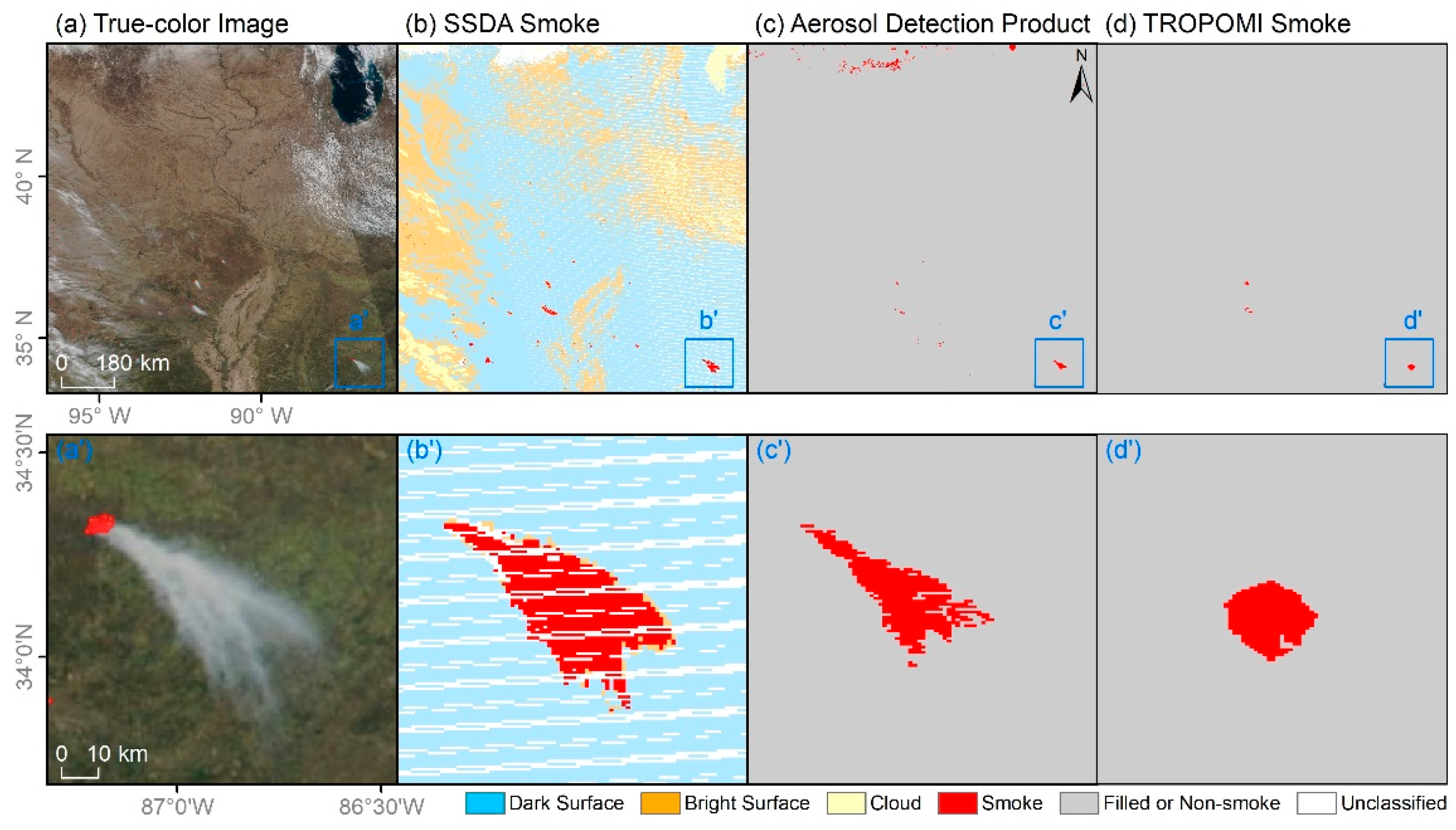
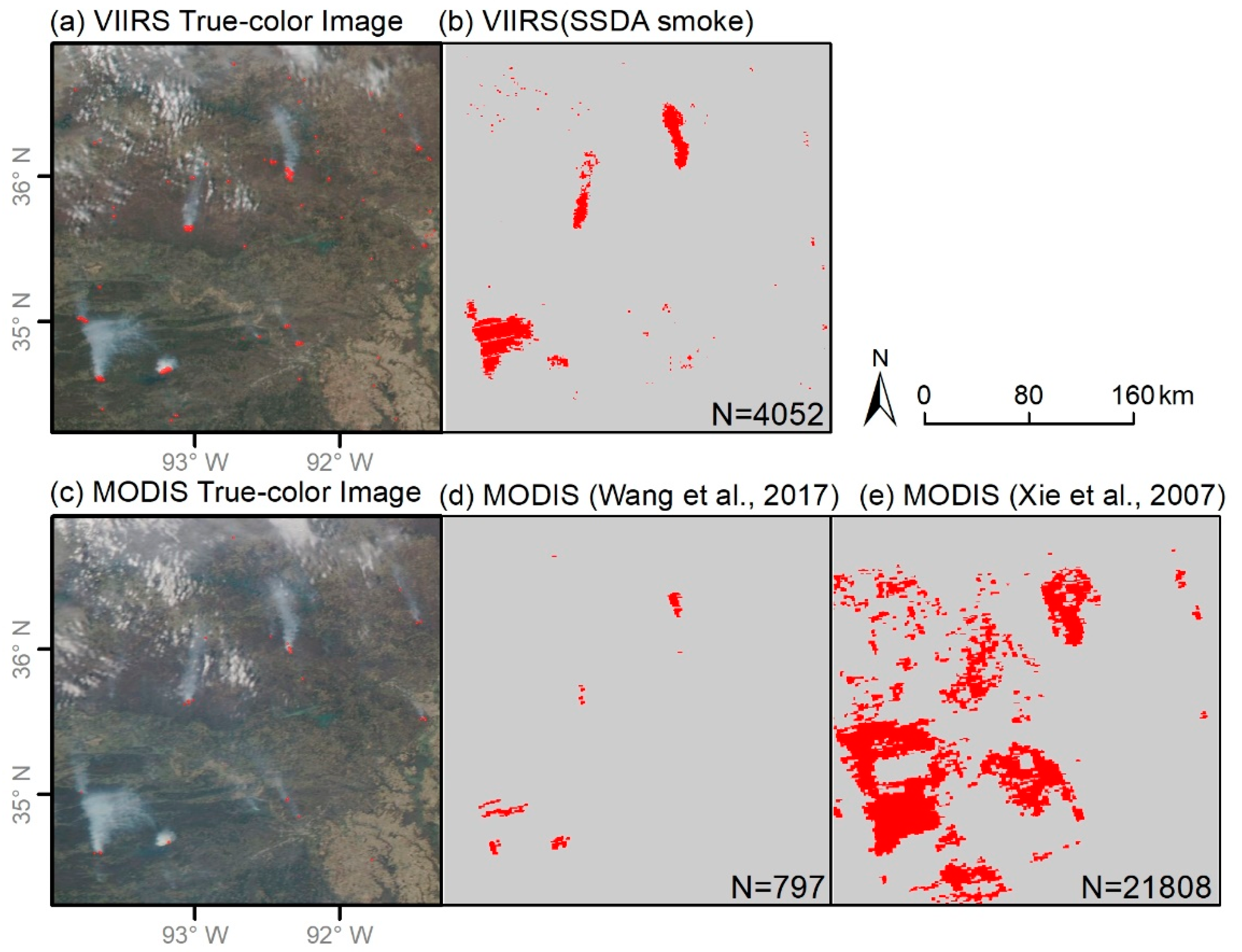
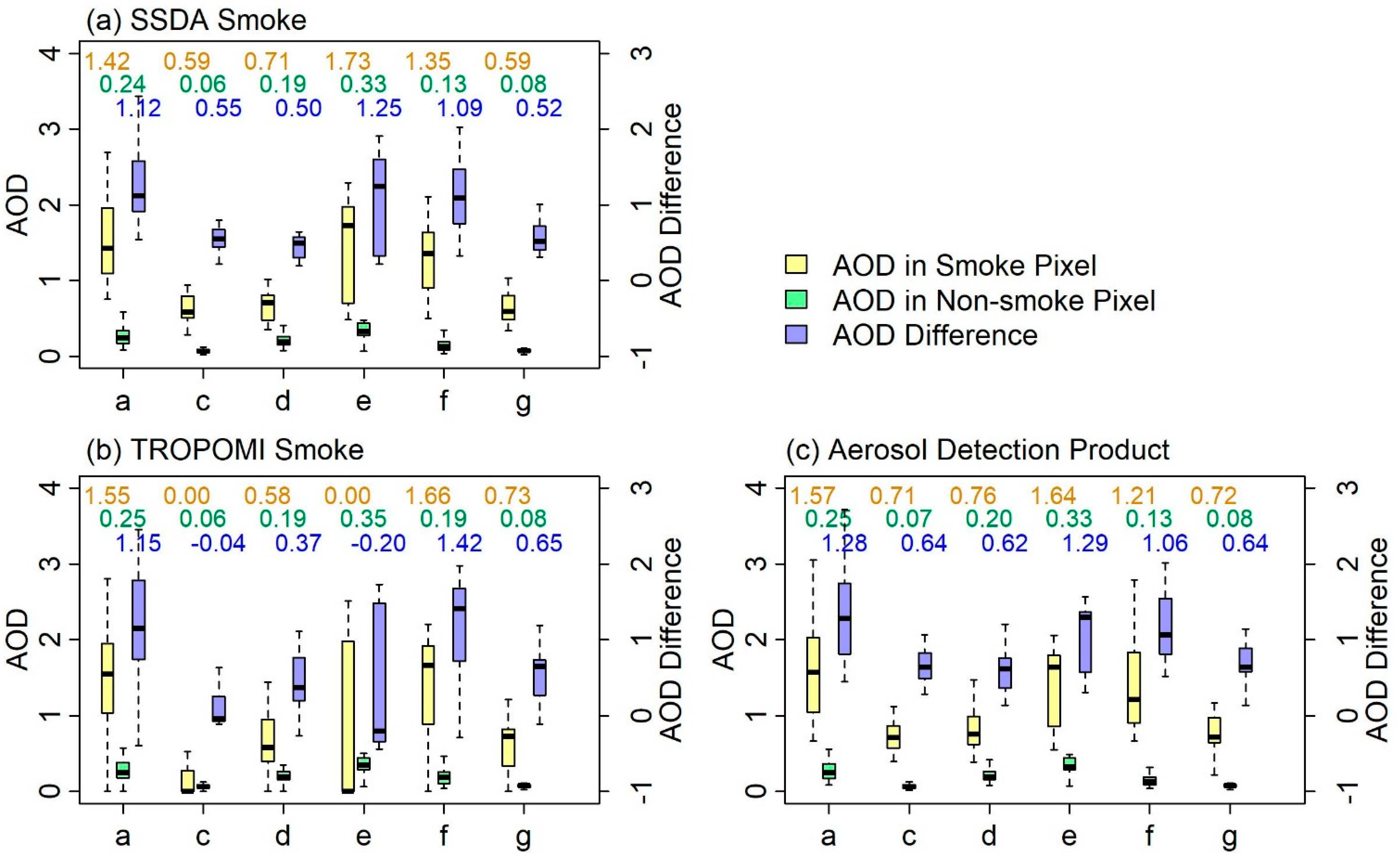
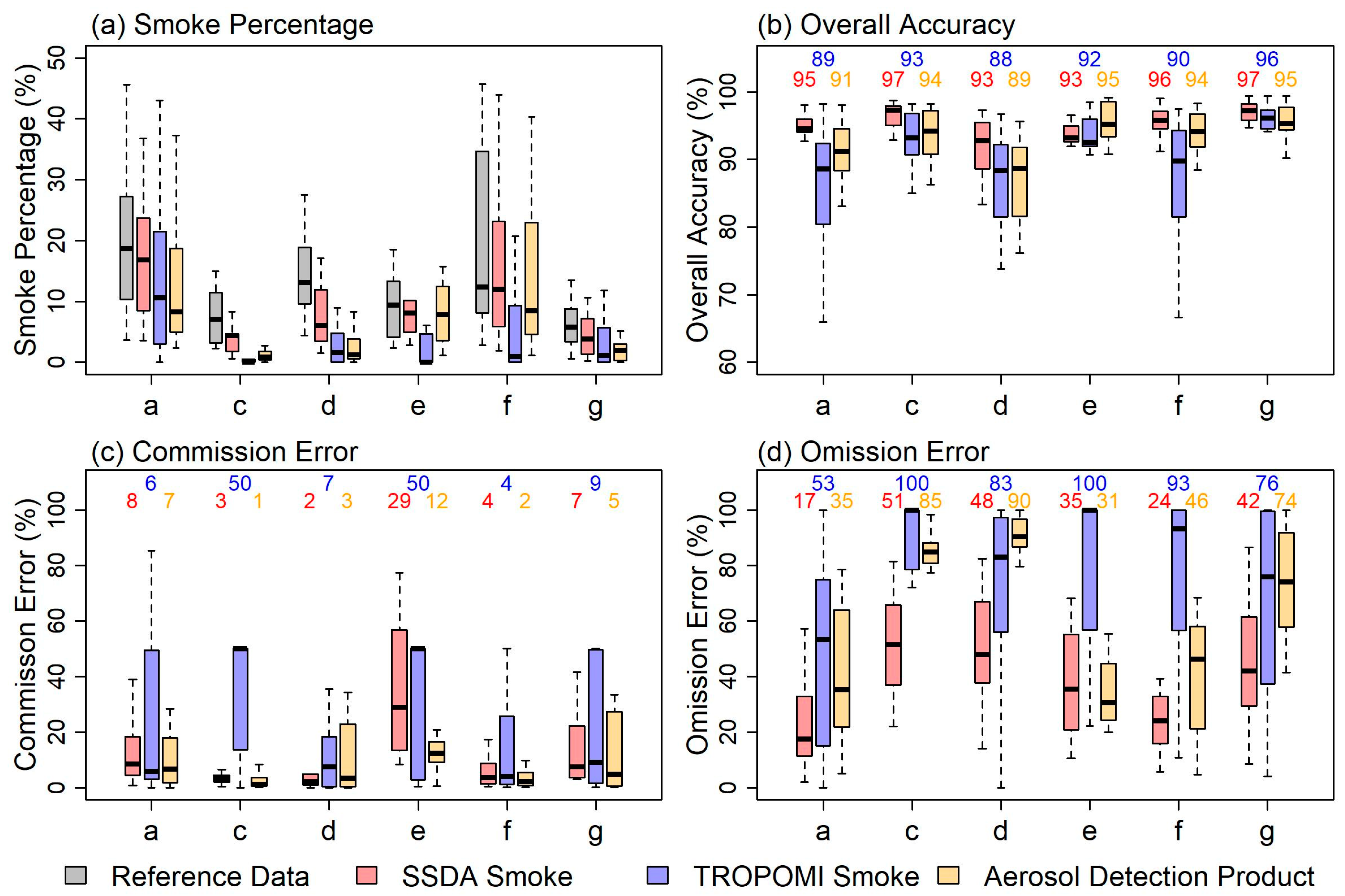
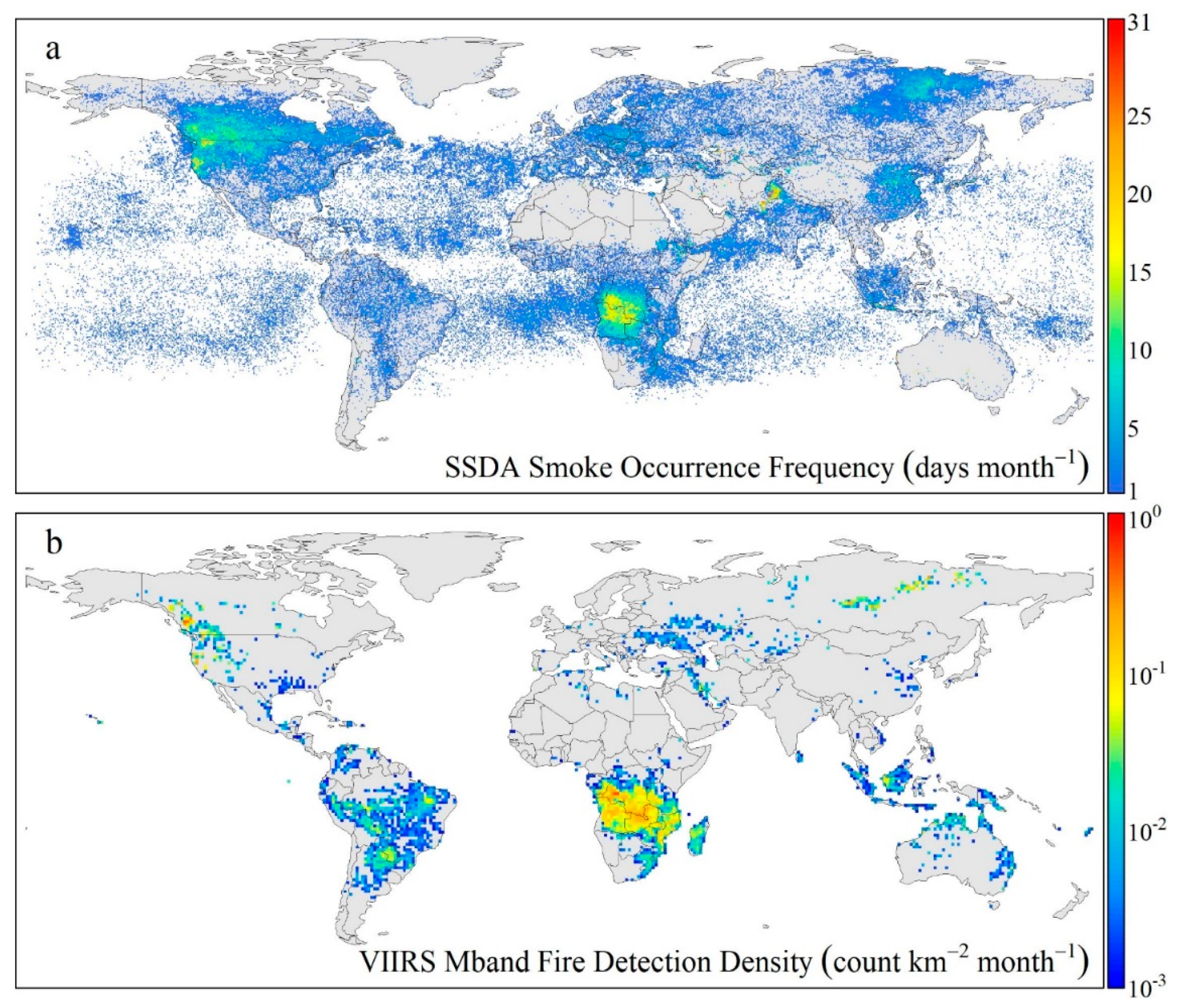
| VIIRS Band | Center Wavelength (µm) | Spectral Range (µm) |
|---|---|---|
| M3 | 0.488 | 0.478–0.498 |
| M4 | 0.555 | 0.545–0.565 |
| M5 | 0.672 | 0.662–0.682 |
| M7 | 0.865 | 0.846–0.885 |
| M8 | 1.240 | 1.230–1.250 |
| M10 | 1.610 | 1.580–1.640 |
| M11 | 2.250 | 2.225–2.275 |
| M16 | 12.013 | 11.538–12.488 |
| Region ID | Region of Interest | Acquisition Date | Acquisition Time (UTC) | Sample Types |
|---|---|---|---|---|
| a | West North America | 20180820 | 21:27 | Smoke, cloud, bright surface |
| b | East North America | 20190319 | 18:48 | Smoke, cloud, bright surface |
| c | South America | 20160912 | 17:08 | Smoke, cloud, bright surface |
| d | Africa | 20160917 | 12:10 | Smoke, cloud, bright surface |
| e | Indonesia | 20160828 | 06:43 | Smoke, cloud |
| f | Siberia | 20170807 | 04:26 | Smoke, cloud |
| g | Australia | 20180917 | 03:54 | Smoke, bright surface |
| Sahara | 20180810 | 12:43 | Dust | |
| Sahara | 20180818 | 13:36 | Dust |
Publisher’s Note: MDPI stays neutral with regard to jurisdictional claims in published maps and institutional affiliations. |
© 2021 by the authors. Licensee MDPI, Basel, Switzerland. This article is an open access article distributed under the terms and conditions of the Creative Commons Attribution (CC BY) license (http://creativecommons.org/licenses/by/4.0/).
Share and Cite
Lu, X.; Zhang, X.; Li, F.; Cochrane, M.A.; Ciren, P. Detection of Fire Smoke Plumes Based on Aerosol Scattering Using VIIRS Data over Global Fire-Prone Regions. Remote Sens. 2021, 13, 196. https://doi.org/10.3390/rs13020196
Lu X, Zhang X, Li F, Cochrane MA, Ciren P. Detection of Fire Smoke Plumes Based on Aerosol Scattering Using VIIRS Data over Global Fire-Prone Regions. Remote Sensing. 2021; 13(2):196. https://doi.org/10.3390/rs13020196
Chicago/Turabian StyleLu, Xiaoman, Xiaoyang Zhang, Fangjun Li, Mark A. Cochrane, and Pubu Ciren. 2021. "Detection of Fire Smoke Plumes Based on Aerosol Scattering Using VIIRS Data over Global Fire-Prone Regions" Remote Sensing 13, no. 2: 196. https://doi.org/10.3390/rs13020196
APA StyleLu, X., Zhang, X., Li, F., Cochrane, M. A., & Ciren, P. (2021). Detection of Fire Smoke Plumes Based on Aerosol Scattering Using VIIRS Data over Global Fire-Prone Regions. Remote Sensing, 13(2), 196. https://doi.org/10.3390/rs13020196








